
Installing a Variable Refrigerant Flow (VRF) system requires precision, experience, and adherence to technical standards.
A well-executed installation ensures high efficiency, stable operation, and long equipment life.
Here’s a practical guide to best practices for VRF installation in offices, hotels, and commercial buildings across the UK.
1. System Design and Load Calculation
Accurate load calculation is the foundation of every VRF project.
Use CIBSE Guide A or ASHRAE standards to determine cooling and heating requirements per zone.
Over-sizing leads to short cycling, while under-sizing reduces comfort.
Include internal heat gains from people, lighting, and equipment when designing system capacity.
2. Piping Layout
Refrigerant piping should follow manufacturer specifications for diameter, maximum length, and vertical lift.
Typical limits:
-
Total length: up to 1 000 m
-
Vertical separation: 50–90 m
Avoid unnecessary bends and joints to reduce pressure drop.
Always use refrigerant-grade copper pipes, properly insulated with closed-cell insulation (13–19 mm thick) to prevent condensation.
3. Branch Selector (BS) Box Placement
For heat recovery systems, position BS boxes centrally to minimise refrigerant path length to indoor units.
Avoid locating them above ceilings with limited access — maintenance clearance of 600 mm on all sides is recommended.
4. Electrical Wiring and Power Supply
Each outdoor module requires a dedicated power circuit with appropriate MCB and RCD protection.
Follow local BS 7671 (IET Wiring Regulations) for cable sizing and circuit design.
Separate power and communication wiring to prevent interference.
5. Refrigerant Charging and Leak Testing
Before commissioning, perform nitrogen pressure testing (usually 3.8 MPa) to detect leaks.
Once verified, conduct vacuum dehydration to remove moisture from the system — minimum vacuum level: 500 microns.
Charge refrigerant strictly by weight as per the manufacturer’s label; incorrect charge affects efficiency and reliability.
6. Drainage and Condensate Management
Ensure each indoor unit has a proper drain connection with trap depth >50 mm to prevent odour backflow.
If ceiling height is limited, use condensate pumps with lift height up to 850 mm.
7. Commissioning and Balancing
During commissioning:
-
Check communication between indoor and outdoor units.
-
Balance refrigerant flow using pressure sensors.
-
Record operating parameters: suction pressure, discharge temperature, superheat, and sub-cooling.
A proper commissioning log ensures warranty validity and ongoing performance tracking.
8. Sound and Vibration Control
Install outdoor units on anti-vibration mounts and ensure airflow clearance on all sides (minimum 300 mm rear, 1 000 mm front).
Indoor noise levels can be fine-tuned by adjusting fan speeds and diffuser settings.
9. Maintenance Access
Plan for easy service access to filters, electrical panels, and refrigerant valves.
Poor access increases future maintenance costs and downtime.
10. Documentation and Handover
Provide clients with as-built drawings, operating manuals, and maintenance schedules.
Record refrigerant quantity, model numbers, and test certificates for F-Gas compliance.
Conclusion
A properly designed and installed VRF system ensures energy efficiency, comfort, and reliability for decades.
By following professional installation practices and adhering to UK regulations, contractors and facility owners can guarantee long-term performance and minimal maintenance costs.








